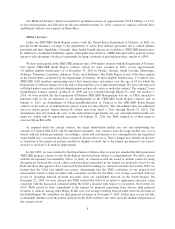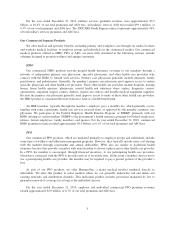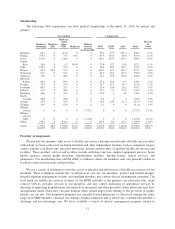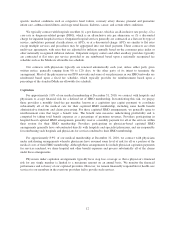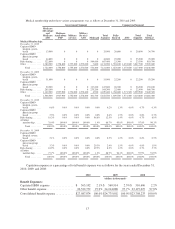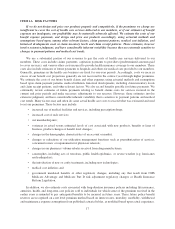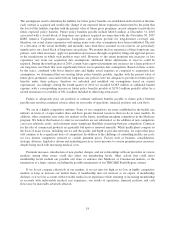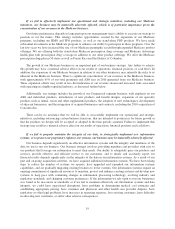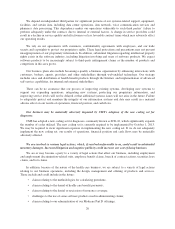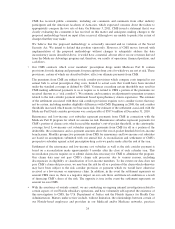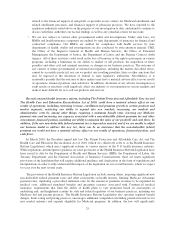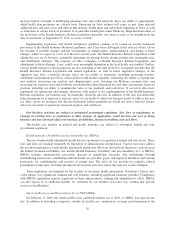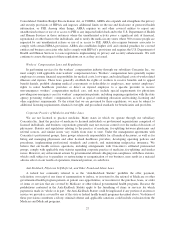Humana 2010 Annual Report Download - page 28
Download and view the complete annual report
Please find page 28 of the 2010 Humana annual report below. You can navigate through the pages in the report by either clicking on the pages listed below, or by using the keyword search tool below to find specific information within the annual report.The assumptions used to determine the liability for future policy benefits are established and locked in at the time
each contract is acquired and would only change if our expected future experience deteriorated to the point that
the level of the liability, together with the present value of future gross premiums, are not adequate to provide for
future expected policy benefits. Future policy benefits payable include $824.6 million at December 31, 2010
associated with a closed block of long-term care policies acquired in connection with the November 30, 2007
KMG America Corporation acquisition. Long-term care policies provide for long-duration coverage and,
therefore, our actual claims experience will emerge many years after assumptions have been established. The risk
of a deviation of the actual morbidity and mortality rates from those assumed in our reserves are particularly
significant to our closed block of long-term care policies. We monitor the loss experience of these long-term care
policies, and, when necessary, apply for premium rate increases through a regulatory filing and approval process
in the jurisdictions in which such products were sold. However, to the extent premium rate increases or loss
experience vary from our acquisition date assumptions, additional future adjustments to reserves could be
required. During the fourth quarter of 2010, certain states approved premium rate increases for a large portion of
our long-term care block that were significantly below our acquisition date assumptions. Based on these actions
by the states, combined with lower interest rates and higher actual expenses as compared to acquisition date
assumptions, we determined that our existing future policy benefits payable, together with the present value of
future gross premiums, associated with our long-term care policies were not adequate to provide for future policy
benefits under these policies; therefore we unlocked and modified our assumptions based on current
expectations. Accordingly, during the fourth quarter of 2010 we recorded $138.9 million of additional benefit
expense, with a corresponding increase in future policy benefits payable of $170.3 million partially offset by a
related reinsurance recoverable of $31.4 million included in other long-term assets.
Failure to adequately price our products or estimate sufficient benefits payable or future policy benefits
payable may result in a material adverse effect on our results of operations, financial position, and cash flows.
We are in a highly competitive industry. Some of our competitors are more established in the health care
industry in terms of a larger market share and have greater financial resources than we do in some markets. In
addition, other companies may enter our markets in the future, including emerging competitors in the Medicare
program. We believe that barriers to entry in our markets are not substantial, so the addition of new competitors
can occur relatively easily, and customers enjoy significant flexibility in moving between competitors. Contracts
for the sale of commercial products are generally bid upon or renewed annually. While health plans compete on
the basis of many factors, including service and the quality and depth of provider networks, we expect that price
will continue to be a significant basis of competition. In addition to the challenge of controlling health care costs,
we face intense competitive pressure to contain premium prices. Factors such as business consolidations,
strategic alliances, legislative reform and marketing practices create pressure to contain premium price increases,
despite being faced with increasing medical costs.
Premium increases, introduction of new product designs, and our relationships with our providers in various
markets, among other issues, could also affect our membership levels. Other actions that could affect
membership levels include our possible exit from or entrance into Medicare or Commercial markets, or the
termination of a large contract, including the possible termination of our TRICARE South Region contract.
If we do not compete effectively in our markets, if we set rates too high or too low in highly competitive
markets to keep or increase our market share, if membership does not increase as we expect, if membership
declines, or if we lose accounts with favorable medical cost experience while retaining or increasing membership
in accounts with unfavorable medical cost experience, our results of operations, financial position, and cash
flows may be materially adversely affected.
18


